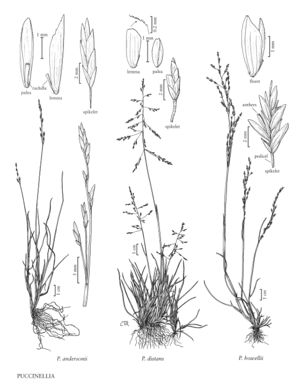Difference between revisions of "Puccinellia howellii"
FNA>Volume Importer |
imported>Volume Importer |
||
| (4 intermediate revisions by 2 users not shown) | |||
| Line 17: | Line 17: | ||
-->{{Treatment/Body | -->{{Treatment/Body | ||
|distribution=Calif. | |distribution=Calif. | ||
| − | |discussion=<p>Puccinellia howellii is known only from the type locality in Shasta County, California, where it is a dominant element of the vegetation associated with a group of three mineralized seeps. Isozyme profiles suggest that it is a polyploid.</p> | + | |discussion=<p><i>Puccinellia howellii</i> is known only from the type locality in Shasta County, California, where it is a dominant element of the vegetation associated with a group of three mineralized seeps. Isozyme profiles suggest that it is a polyploid.</p> |
|tables= | |tables= | ||
|references= | |references= | ||
| Line 26: | Line 26: | ||
-->{{#Taxon: | -->{{#Taxon: | ||
name=Puccinellia howellii | name=Puccinellia howellii | ||
| − | |||
|authority=J.I. Davis | |authority=J.I. Davis | ||
|rank=species | |rank=species | ||
| Line 34: | Line 33: | ||
|family=Poaceae | |family=Poaceae | ||
|illustrator=Cindy Roché | |illustrator=Cindy Roché | ||
| + | |illustration copyright=Utah State University | ||
|distribution=Calif. | |distribution=Calif. | ||
|reference=None | |reference=None | ||
| Line 39: | Line 39: | ||
|publication year= | |publication year= | ||
|special status= | |special status= | ||
| − | |source xml=https:// | + | |source xml=https://bitbucket.org/aafc-mbb/fna-data-curation/src/200273ad09963decb8fc72550212de541d86569d/coarse_grained_fna_xml/V24/V24_680.xml |
|subfamily=Poaceae subfam. Pooideae | |subfamily=Poaceae subfam. Pooideae | ||
|tribe=Poaceae tribe Poeae | |tribe=Poaceae tribe Poeae | ||
Latest revision as of 16:24, 11 May 2021
Plants perennial; cespitose, not mat-forming. Culms 7-40 cm, erect to ascending. Ligules 1.5-2.7 mm, obtuse, entire or minutely and irregularly serrate; blades involute, 1.4-2.2 mm wide when flattened. Panicles 2-13 cm, compact to diffuse at maturity, lower branches erect to descending, spikelet-bearing from near the base or confined to the distal 1/2; pedicels smooth or with a few scattered scabrules, sometimes with tumid epidermal cells. Spikelets 3-8 mm, with (1)2-5 florets. Glumes rounded or weakly keeled over the back, veins obscure, apices acute to obtuse; lower glumes 0.8-1.9 mm; upper glumes 1.7-2.5 mm; calluses with a few hairs; lemmas 2.4-3.3 mm, herbaceous, glabrous or with a few hairs near the base, principally along the veins, backs rounded or weakly keeled distally, 5-veined, veins obscure, not extending to the margins, apical margins uniformly and densely scabrous, apices acute to obtuse, entire; palea veins smooth and glabrous proximally, smooth or scabrous distally; anthers 1.5-2 mm. 2n = unknown.
Discussion
Puccinellia howellii is known only from the type locality in Shasta County, California, where it is a dominant element of the vegetation associated with a group of three mineralized seeps. Isozyme profiles suggest that it is a polyploid.
Selected References
None.
